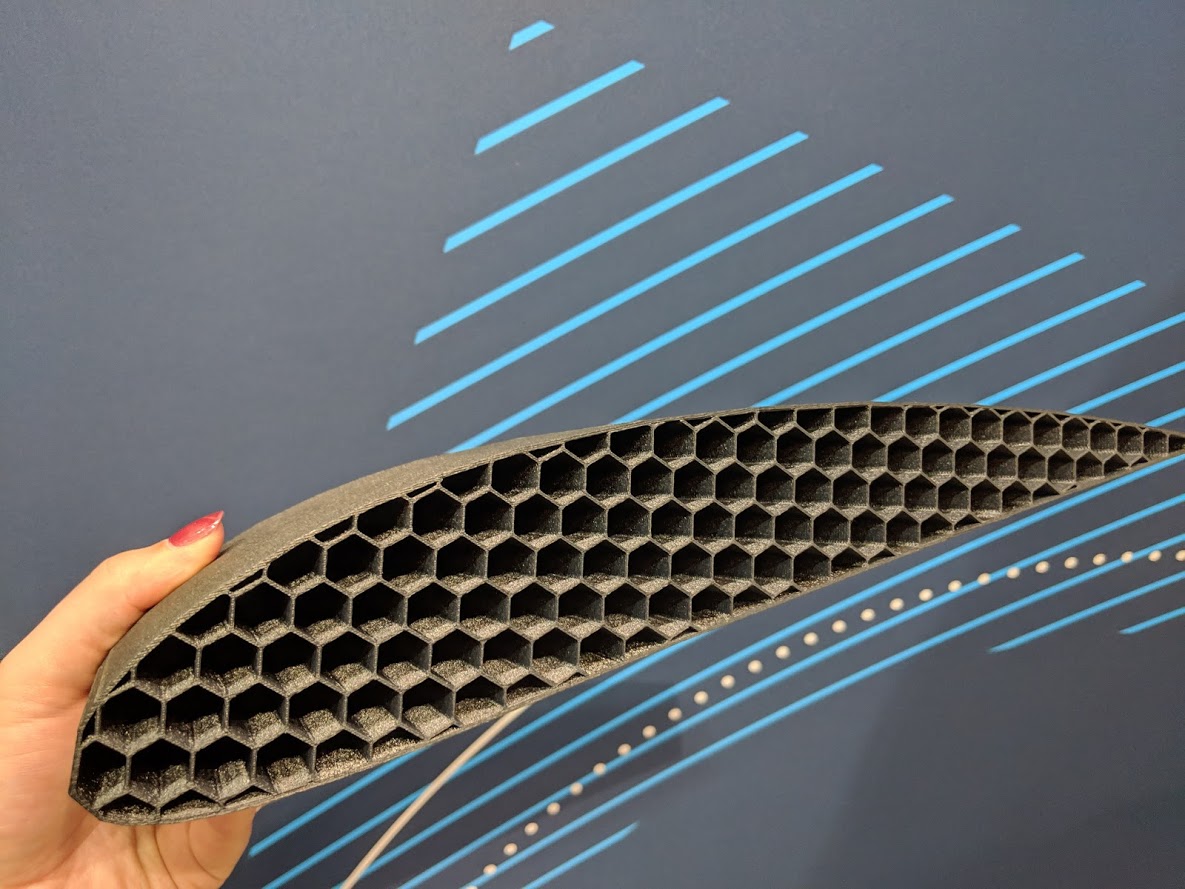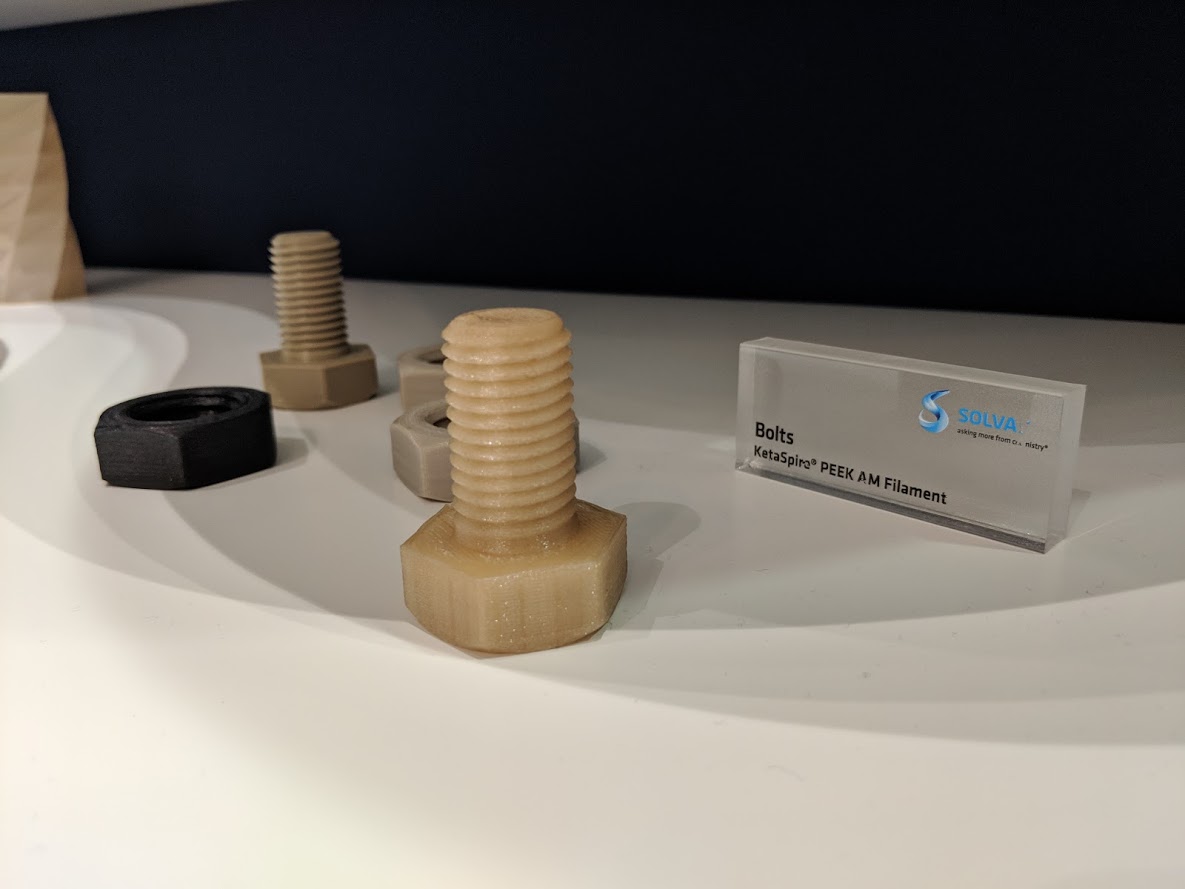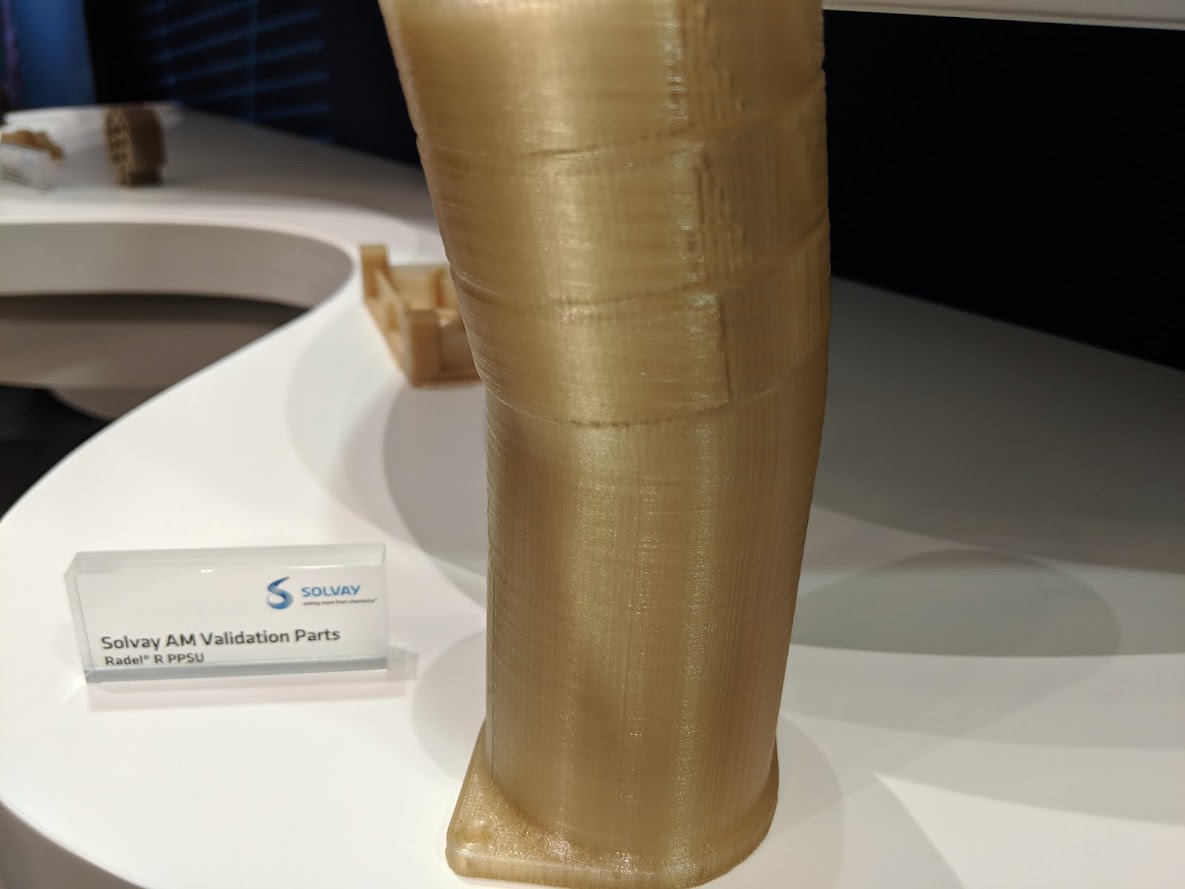![Christophe Schramm, Additive Manufacturing Business Manager, Solvay Specialty Polymers at formnext 2018 [Image: Fabbaloo]](https://fabbaloo.com/wp-content/uploads/2020/05/IMG_20181114_173201_img_5eb0a1d451c63.jpg)
Global advanced materials and specialty chemicals company Solvay is increasing its focus on 3D printing with new introductions and much more in the works.
Christophe Schramm, Additive Manufacturing Business Manager at Solvay’s Specialty Polymers global business unit, shared a look at the company’s latest when we sat down recently in Frankfurt to catch up at formnext. The company had just announced three new medical-grade filaments — PEEK, carbon-filled PEEK, and PPSU — for limited-contact applications in healthcare, and we can expect to hear a lot more from the busy team at Solvay Specialty Polymers going forward.
The new materials, Solvay’s first medical-grade filaments for 3D printing, include KetaSpire PEEK (NT1 HC) and KetaSpire PEEK with a 10% carbon fiber reinforcement (CF10 HC), along with a Radel PPSU (NT1 HC). These new introductions are intended to work toward filling a gap in high-performance materials able to meet the unique needs and regulations of healthcare usage. Indicated for up to 24-hour contact with bodily fluids, these materials can be used in applications such as 3D printing medical instruments that go into the body but don’t stay there, Schramm noted.



Solvay paid particular attention to biocompatibility testing, which “takes quite a bit of time and money,” he added, to gain approvals such as FDA 510(k) clearance in the US and the CE mark in the EU. The benefits are worth it, as Solvay is “enabling the healthcare market to create guides and more via 3D printing with these materials,” Schramm said.
“We’re quite some time away from ‘boring’,” he said as I asked what that timeline might look like (I’m of the opinion 3D printing should be somewhat boring).
“We work with 35 families of high-performance polymers, and only two of these are in additive manufacturing. Even in those two families, we’ve only scratched the surface. For a materials technology provider like us, we’re still working toward the holy grail of Z-strength. There’s a hell of a lot of work ahead. We need to increase speed and reliability, which is a big challenge for powders. There’s a lot developing. In composites, there’s a world out there of what we can still do. I’m not afraid of getting bored anytime soon.”
Indeed, he said, now it’s starting to get real.
Last year, Solvay didn’t have a booth at formnext. I first met Schramm at this year’s RAPID + TCT in the spring, and he noted a difference between the two events with many more visitors coming to see the company’s booth at formnext than at RAPID; just a few months led to an observable “increased interest in additive manufacturing” among well-informed visitors. That, he said, is “definitely something that’s a positive sign.” This year’s formnext was particularly well received, with several exhibitors noting the uptick in attendees who were engaged and informed; Schramm pointed as well to overall growth and noted that he was “seeing ecosystems coming together.”
“We’re seeing more being qualified, seeing service bureaus doing real projects with real customers. The tide is turning from frontrunners in aerospace and automotive to encompass more — in oil and gas, consumer industrial, construction, and medical industries. We really believe there’s significant potential — and, yes, a long way to go,” Schramm said.
“We’re in early iterations now in a long cycle of innovation. We’re finding customers willing to take some risk with adoption.”
These patterns of growth speak to larger trends in the 3D printing industry, which the team at Solvay is keeping close tabs on. One of the major throughlines of this year’s formnext came up as Solvay is also examining simulation. Solvay maintains a digital database where simulation is coming into play; more materials are in the pipeline to be available in the database. Schramm noted that more needs to be done in that space as material and design interface yields interesting things. Lightweighting, a popular design approach to leverage the benefits of additive manufacturing, often removes unneeded material — and while “you may need less material, there’s more value added,” Schramm noted as higher-value materials lead to higher-quality builds. To discern approaches here, Solvay is looking to the digital twin.
“WIth the digital twin to simulate processes, we are working with companies out there to see how this fits in to the material space. We’re well positioned to participate in this space when it’s ready for materials,” Schramm said.
Positioning is important as additive manufacturing industrializes — so what about another major theme at formnext?
“All I can say is — yes, customers have approached us about serial production,” he said.
Healthcare is an application area he was at liberty to discuss, and we looked to Solvay’s two decades of experience in this arena with their resins. The company understands the regulations in place and is already working with many OEMs, positioning them well in this market as well.
In April, Solvay introduced a relatively new business model with its AM Shop. Offering transparent pricing and full information, the e-commerce platform serves as a portal to simulation, testing, and prototyping services also linking with partners. Knowing this model is unusual, Schramm said that, “We’re learning a lot doing this, and seeing interesting traction.”
To close out our chat, we looked ahead — and kept coming back to two key words: “Stay tuned.” There’s a good bit of work in the pipeline now at Solvay, which offers what Schramm describes as the broadest portfolio of high-performance polymers in the industry. Some will be coming out soon (stay tuned), and there will be more to come in more polymer families.
“We’ll stay agile, paying attention to customer demand,” Schramm said.
Without naming any specifics for what to expect next (stay tuned), Solvay has been responsive to inquiries for a broader range of additive manufacturing materials.
With the three newly announced healthcare materials on the market now in North America and Europe, Solvay is highlighting an important quality: follow-through.
“We’re doing what we said,” Schramm noted. “We’re growing our ecosystem rapidly with more partnerships, and will continue to grow our portfolio with market demand. Stay tuned.”
Via Solvay and Solvay AM Shop











An inventive designer has developed a method for producing 3D paper objects using recycled paper and 3D printed molds.